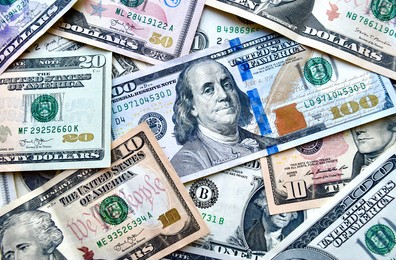The dimensions of a dollar bill are 6.14 inches in length and 2.61 inches in width along with a thickness of 0.0043 inches (0.11 millimeters).
The first dollar bill came into circulation in 1690, issued by the Massachusetts Bay Colony.
In this post, I will provide you with a comprehensive overview of the dimensions of the dollar bill and its evolution over time, along with the reasons behind its transformation.
Standard Dimensions of US Dollar Bills

The standard dimensions of US dollar bills, also known as Federal Reserve Notes, are as follows:
1 Dollar Bill:
Width: 6.14 inches (155.956 mm)
Height: 2.61 inches (66.294 mm)
5 Dollar Bill:
Width: 6.14 inches (155.956 mm)
Height: 2.61 inches (66.294 mm)
10 Dollar Bill:
Width: 6.14 inches (155.956 mm)
Height: 2.61 inches (66.294 mm)
20 Dollar Bill:
Width: 6.14 inches (155.956 mm)
Height: 2.61 inches (66.294 mm)
50 Dollar Bill:
Width: 6.14 inches (155.956 mm)
Height: 2.61 inches (66.294 mm)
100 Dollar Bill:
Width: 6.14 inches (155.956 mm)
Height: 2.61 inches (66.294 mm)
Rationale Behind the Choice of These Specific Dimensions.

Now, let’s discuss the rationale behind the choice of these specific dimensions.
The dimensions of US dollar bills have remained consistent across different denominations for many years. The primary reason for using the same dimensions for various bills is practicality and convenience in handling and processing. Here are a few reasons:
Standardization:
Keeping the dimensions the same for all bills simplifies the manufacturing and printing processes. The Bureau of Engraving and Printing (BEP), which is responsible for producing US currency, can utilize standardized equipment and processes, resulting in efficiency and cost-effectiveness.
Handling and Storage:
Uniform dimensions make it easier for individuals and financial institutions to handle and store different denominations of bills. They can be neatly stacked, organized, and transported without the need for separate compartments or special arrangements.
Vending Machines and ATMs:
Many vending machines, ATMs, and other automated cash-handling devices are designed to accommodate a standard-sized bill. By maintaining consistent dimensions, these machines can reliably accept and dispense different denominations without the need for complex adjustments or modifications.
Counterfeit Detection:
Having consistent dimensions across different bills aids in the identification of counterfeit currency. People become accustomed to the size of genuine bills, making it easier to spot discrepancies when handling potentially fraudulent notes.
International Recognition:
The US dollar is a widely recognized and accepted currency around the world. Maintaining consistent dimensions helps ensure that US dollar bills are easily distinguishable from other currencies during international transactions and reduces the likelihood of confusion or errors.
History of Dollar Bill Dimensions
The history of US banknotes has many changes. The first paper bills were made in 1861, and they were called Demand Notes. People could exchange them for gold or silver at specific banks in the US.
US banknotes have changed and improved over time. The first paper bills, called Demand Notes, were used for about two years in 1861. After that, they were replaced by United States Notes in 1862, which looked more like the banknotes we use today. From 1862 to 1929, the size of US banknotes stayed the same, measuring 7.375 × 3.125 inches (18.7 × 7.9 centimeters).
What are the Dollar Bills Made Of?
Dollar bills, specifically those issued in the United States, are made of a combination of materials. The primary material used in the production of dollar bills is a type of paper known as “currency paper” or “rag paper.” This paper is made from a mixture of cotton and linen fibers, which gives it durability and a distinctive texture.
To enhance its strength and prevent counterfeiting, the currency paper is embedded with security features. These features include tiny red and blue security fibers scattered throughout the paper, as well as a security thread—a thin strip embedded within the paper that appears as a continuous line when held up to the light.
Additionally, the ink used to print the design and text on the bills contains unique properties to deter counterfeiting. The ink is formulated with a mix of special pigments that create colors that are difficult to replicate accurately.
How Long Does Paper Money Last?
The lifespan of paper money, also known as banknotes, can vary depending on factors such as usage, environmental conditions, and denomination. On average, a banknote can last in circulation for about 5 to 15 years.
The lifespan of a banknote is affected by the amount of wear and tear it receives during circulation. The more a banknote is handled and passed from person to person, the more likely it is to wear out and become unusable. Environmental factors such as humidity, temperature, and exposure to sunlight can also cause banknotes to degrade and shorten their lifespan.
The denomination of the banknote can also affect its lifespan. Higher denomination notes are often used less frequently and are more likely to be stored in wallets or bank vaults, meaning they may last longer than lower denomination notes that are used more often.
FAQs
What are the dimensions of a dollar bill in MM?
The dimensions of a US dollar bill are approximately 66.3 mm in width and 156.1 mm in length.
How long is a dollar bill in CM?
Converting the length of a dollar bill to centimeters, it is approximately 15.61 cm.
What is the size of a 100-dollar bill in CM?
The size of a 100-dollar bill is the same as a regular dollar bill, with dimensions of approximately 66.3 mm in width and 156.1 mm in length. Therefore, the size of a 100-dollar bill is also approximately 15.61 cm in length.
What size is a 50-dollar bill?
The size of a 50-dollar bill is the same as a regular dollar bill, with dimensions of approximately 66.3 mm in width and 156.1 mm in length. Hence, the size of a 50-dollar bill is also approximately 15.61 cm in length.